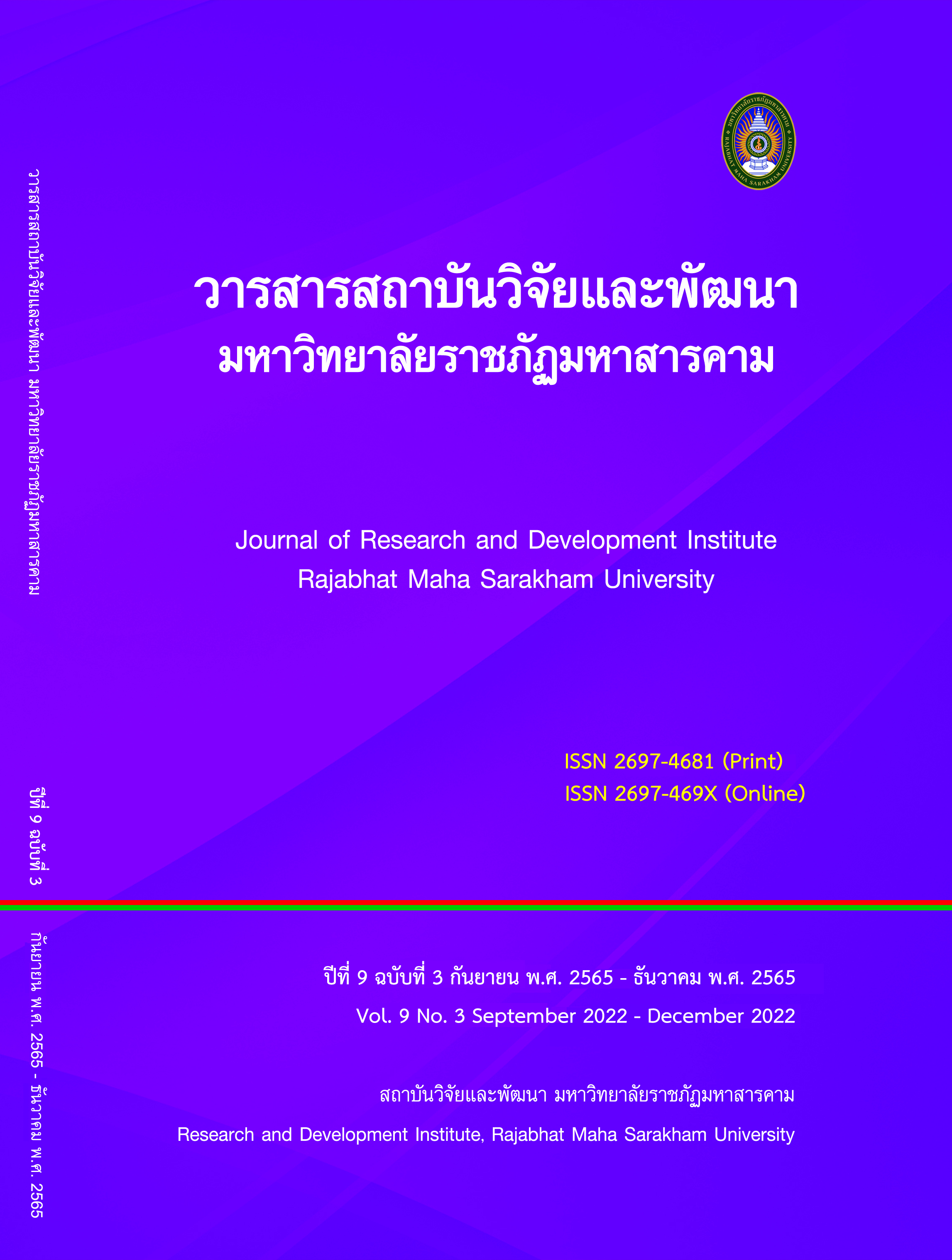ปัจจัยที่มีอิทธิพลต่อความตั้งใจซื้อคอร์สเรียนรู้ออนไลน์
คำสำคัญ:
คอร์สเรียนออนไลน์, ผู้ให้บริการความรู้ออนไลน์, ความเชื่อมั่นในการจ่ายเงิน, ความตั้งใจซื้อบทคัดย่อ
การวิจัยนี้มีวัตถุประสงค์เพื่อ (1) ศึกษาปัจจัยที่มีอิทธิพลต่อความตั้งใจซื้อคอร์สเรียนรู้ออนไลน์ (2) เปรียบเทียบระดับปัจจัยที่ส่งผลต่อความตั้งใจซื้อคอร์สเรียนรู้ออนไลน์ โดยมีกรอบแนวคิดของงานวิจัยประยุกต์จากแนวคิดและทฤษฎีเกี่ยวกับคุณค่าของการบริโภค (Theory of Consumption Value) กรอบแนวคิด Cognitive–Affective–Conative งานวิจัยนี้ใช้การสำรวจโดยการเก็บข้อมูลจากแบบสอบถามออนไลน์ ประชากรในเขตกรุงเทพมหานครและปริมณฑล ใช้วิธีการสุ่มตัวอย่างแบบชั้นภูมิจากกลุ่มตัวอย่าง จำนวน 565 คนและวิเคราะห์ข้อมูลด้วยแบบจำลองสมการโครงสร้าง (SEM)
ผลการวิจัยพบว่า (1) ปัจจัยที่มีอิทธิพลต่อความตั้งใจซื้อคอร์สเรียนรู้ ประกอบด้วย ความเชื่อมั่นต่อแพลตฟอร์ม ตัวตนของผู้ให้บริการความรู้หรือแบรนด์ และความเชื่อมั่นในการชำระเงินซื้อความรู้ โดยมีปัจจัยสนับสนุนให้เกิดความเชื่อมั่นในการชำระเงินซื้อความรู้ ประกอบด้วย คุณภาพของความรู้ อรรถประโยชน์ด้านราคา การรับรู้ถึงความเพลิดเพลิน และอิทธิพลของโซเชียล เมื่อผู้เรียนรับรู้ถึงคุณประโยชน์จากปัจจัยดังกล่าวอันส่งผลให้เกิดความเชื่อมั่นและมีความตั้งใจที่จะซื้อความรู้จากหลักสูตรคอร์สเรียนรู้ออนไลน์อย่างมีนัยสำคัญ (2) ตัวตนของผู้ให้บริการความรู้ เช่น ตราสินค้าหรือแบรนด์ ความความโดดเด่นของเนื้อหาความรู้ ฯลฯ มีระดับค่าเฉลี่ยสูงสุดที่เป็นปัจจัยทำให้เกิดความตั้งใจซื้อคอร์สเรียนรู้ออนไลน์ รองลงมาคือความเชื่อมั่นในการชำระเงินซื้อความรู้ซึ่งเกิดจากผู้เรียนมีความเชื่อมั่นต่อแพลตฟอร์ม การรับรู้ถึงความเพลิดเพลิน อรรถประโยชน์ด้านราคา อิทธิพลของโซเชียลมีเดีย และคุณภาพความรู้ตามลำดับ
เอกสารอ้างอิง
Albert, Noel., Merunka, Dwight., Pierre, Valette-Florence. (2013). Brand passion: Antecedents and consequences. Journal of Business Research, 66, 904-909.
ALNasser, Mohammad., Yusoff, Rushami Zien., Islam, Rabiul., ALNasser, Abdullah. (2013). E-Service Quality and its Effect on Consumers’ Perceptions Trust. American Journal of Economics and Business Administration, 5(2), 47-55.
Alhaddad, Abdullah. (2015). A STRUCTURAL MODEL OF THE RELATIONSHIPS BETWEEN BRAND IMAGE, BRAND TRUST AND BRAND LOYALTY. International Journal of Management Research & Review, 5(3), 137-144.
Abdullah, Fazil., Ward, Rupert., Ahmed, Ejaz., (2016). Investigating the influence of the most commonly used external variables of TAM on students’ Perceived Ease of Use (PEOU) and Perceived Usefulness (PU) of e-portfolios. Journal of Computers in Human Behavior, 63, 75-90.
Bhattacharya, C.B., Sen, Sankar. (2017). Consumer-Company Identification: A Framework for Understanding Consumers’ Relationships with Companies. Journal of Marketing, 67(2), 76-88.
Bay Atlantic University. (2020). Online Learning Statistics: Is Online Education the Future?. Retrieved from https://bau.edu/blog/online-learning-statistics/
Chen, Xiayu., Huang, Qian., Davison, Robert M. (2015). What Drives Trust Transfer? The Moderating Roles of Seller-Specific and General Institutional Mechanisms. International Journal of Electronic Commerce, 20(2), 261-289.
Darrat, Aadel A., Darrat, Mahmound A., Amyx, Douglas., (2016). How impulse
buying influences compulsive buying: The central role of consumer anxiety and escapism. Journal of Retailing and Consumer Services, 31, 103-108.
Dabbous, Amal., Barakat, Karine Aoun., Sayegh, May Merhej., (2020). Social
Commerce Success: Antecedents of Purchase Intention and the Mediating Role of Trust. Journal of Internet Commerce, 19(3), 262-297.
Forbes. (2020). The Rise of Online Learning. Retrieved from https://www.forbes.com/sites/ilkerkoksal /2020/ 05/02/the-rise-of-online-learning/?sh=255c130672f3
Fang, Jiaming., Shao, Yunfei., Wen, Chao. (2016). Transactional quality, relational quality, and consumer e-loyalty: Evidence from SEM and fsQCA. International Journal of Information Management, 36, 1205-1217.
Global Market Insights. (2021). E-LEARNING MARKET. Retrieved from https://www.gminsights.com/industry-analysis/elearning-market-size
Gefen, David. (2000). E-commerce: the role of familiarity and trust.
The International Journal of Management Science, 28, 725-737.
Gefen, David., Karahanna, Elena. (2003). TRUST AND TAM IN ONLINE SHOPPING: AN INTEGRATED MODEL. MIS Quarterly, 27(1), 51-90.
Gefen, David., Straub, Detmar W. (2004). Consumer trust in B2C e-commerce and the importance of social presence: experiments in e-Products and e-Services. The International Journal of Management Science, 32, 407-424.
Gallagher, Catherine E., Watt, Margo C., Weaver, Angela D., Murphy, Keely A.,
(2017). “I fear, therefore, I shop” exploring anxiety sensitivity in relation to compulsive buying. Journal of Personality and Individual Differences, 104, 37-42.
Hung, Kineta., Yiyan Li, Stella., Tse, David K. (2011). Interpersonal Trust and
Platform Credibility in a Chinese Multibrand Online Community. Journal of Advertising, 40(3), 103-116.
Hajli, Mahmood. (2012). A research framework for social commerce adoption.
Informational Management and Computer Security, 21(3), 144-154.
Hajli, Nick., Lin, Xiaolin., Featherman, Mauricio., Wang, Yichuan. (2014). Social word of mouth. How trust develops in the market. International Journal of Market Research, 56(5), 1-17.
Hajli, Nick., Sims, Julian., Zadeh, Arash H., Richard, Marie-Odile. (2017).
A social commerce investigation of the role of trust in a social networking site on purchase intentions. Journal of Business Research, 71, 133-141.
Kotler, Philip. & Keller, Kevin Lane. (2012). Marketing Management. (14thed). United States of America: Pearson Education, Inc.
Kim, Hee-Woong., Gupta, Sumeet., Koh, Joon., (2011). Investigating the
intention to purchase digital items in social networking communities: A customer value perspective. Journal of Information and Management, 48, 228-234.
Kim, Sanghyun., Park, Hyunsun. (2013). Effects of various characteristics of
social commerce (s-commerce) on consumers’ trust and trust performance. International Journal of Information Management, 33, 318-332.
Lavidge, Robert J., Steiner, Gary A. (2015). A Model for Predictive Measurements of
Advertising Effectiveness. Journal of Marketing, 25(6), 59-62.
Lee, Dongwon., Moon, Junghoon., Kim, Yong Jin., Yi, Mun Y. (2015). Antecedents and consequences of mobile phone usability: Linking simplicity and interactivity to satisfaction, trust, and brand loyalty. Journal of Information & Management, 52, 295-304.
Moczarny, IM., Villiers, MR. de., Bijon, JA.Van. (2012). How can usability contribute to user experience? A study in the domain of e-commerce. Journal of South African Computer Scientists and Information Technologists, 12, 216-225.
Maia, Claudia., Lunardi, Guiherme., Longaray, Andre., Munhoz, Paulo. (2018). Factors and characteristics that influence consumers’ participation in social commerce. Emerald Publishing Limited, 25(2), 194-211.
Mardi Suryanto, Tri Lathif., Faroqi, Asif., Ridwandono, Doddy., Diah Saftri, Nadia., Ayu Lthriah, Syurfah., Pratama, Arista. (2020). Exploration of User Experience Approach in Using the Digital Commerce Platform on Millennial User in Indonesia. 2020 6th Information Technology International Seminar (ITIS). Surabaya, Indonesia.
Nicola, Stokburger-Sauer., Ratneshwar, S., Sen, Sankar. (2012). Driver of consumer-brand identification. International Journal of Research in Marketing, 29, 406-418.
Oliver, Richard L. (1999). Whence Consumer Loyalty? Jornal of Marketing, 63, 33-44.
Packard, Grant., Wooten, David B., (2013). Compensatory knowledge signaling
in consumer word-of-mouth. Journal of Consumer Psychology, 23(4), 434-450.
Perdana, R.A., Suzianti, A. (2017). Analysis of usability factors affecting purchase intention in online e-commerce sites. The International Conference on Information Technology and Digital Applications.
Sheth, Jagdish N., Newman, Bruce I., Gross, Barbara L. (1991). Why We Buy What We Buy: A Theory of Consumption Values. Journal of Business Research, 22(2), 159-170.
Sweeney, Jillian C. & Soutar, Geoffrey N. (2001). Consumer perceived value: The development of a multiple item Scale. Journal of Retailing, 77, 203-220.
Suryanto, Tri Lathif Mardi., Faroqi, Asif., Ridwandono, Doddy., Saftri, Nadia Diah., Ithriah, Syurfah Ayu., Pratama, Arista. (2020). Exploration of User Experience Approach in Using the Digital Commerce Platform on Millennial User in Indonesia. 6th Information Technology International Seminar (ITIS), 109-114.
Statista. (2021). Share of e-learning participants in Thailand in 2020, by generation age group. Retrieved from https://www.statista.com/statistics/1247816/thailand-share-of-online-learners-by-age-group/
WORLD ECONOMIC FORUM. (2020). The COVID-19 pandemic has changed education forever. This is how. Retrieved from https://www.weforum.org/agenda/2020/04/coronavirus-education-global-covid19-online-digital-learning/
Wang, Wei-Tsong., Wang, Yi-Shun., Liu, En-Ru. (2016). The stickiness intention of group-buying websites: The integration of the commitment–trust theory and e-commerce success model. Journal of Information Management, 53, 625-642.
Zeithaml, Valarie A. (1988). Consumer Perceptions of Price, Quality, and Value: A Means-End Model and Synthesis of Evidence. Journal of Marketing, 52(3), 2-22.
ดาวน์โหลด
เผยแพร่แล้ว
รูปแบบการอ้างอิง
ฉบับ
ประเภทบทความ
สัญญาอนุญาต
ลิขสิทธิ์ (c) 2022 วารสารสถาบันวิจัยและพัฒนา มหาวิทยาลัยราชภัฏมหาสารคาม

อนุญาตภายใต้เงื่อนไข Creative Commons Attribution-NonCommercial-NoDerivatives 4.0 International License.
บทความที่ได้รับการตีพิมพ์เป็นลิขสิทธิ์เป็นของผู้ประพันธ์บทความ







